
SUMMARY
And What You Need To Know As An Entrepreneur
Relations between investors and startups are tricky. At one level, both of them are incentivised enough to grow the business. One of them has a micro level view by virtue of execution and the other has a macro level view by virtue of exposure.
Here’s what a close acquaintance who works as an Investment Manager at a $100 mn. fund told me:
When I wake up every day, all I think is how I can add value to my portfolio companies. If they are successful, I am.
But the situation is not always hunky dory. Barring a few examples of individuals and teams trying to maintain an open dialogue, there is still an atmosphere where founders are wary.
‘They fund copycat models which do not reflect the needs of India’.
‘They fund businesses which are the current flavour of the season’.
‘One does not simply get a meeting with a VC’
The grouse an entrepreneur nurtures against a VC has led to hilarious comics such as these.

(By the way, if you are into comics/ satire on how VCs’ work, this should bring a smile to your face!)
One of the realisations I had was that this might have partially stemmed from the fact that most entrepreneurs were not aware of what it entails to run a VC business in general and why it is even tougher to do it in a country like India.
An equitable understanding of each other will go a long way to nurture the startup scenario, especially in an eco-system that is just coming into its own right.
I look after startup investments and portfolio management at an early stage angel investment network, so I draw my assumptions largely from the following experiences:
- My firm is currently exploring options of raising a micro VC fund/ angel fund(<$20 mn. corpus). I have met with several investors, audit firms and industry consultants to understand the market.
- General conversations with Principals/ Managers at funds across India after long discussions involving positioning of our current portfolio of startups for their next round of fundraise.
- The constant chatter you hear in investor circles and the information flow you are exposed to by virtue of being in the industry
Full Disclaimer: An early stage angel network provides curated investment opportunities and draws the invested money from individual angel investors. We operate on the annual membership fee we charge for our services. Investing into quality startups and later managing the portfolio becomes key to drive a network’s business and build credibility.
The venture capital business is a 100% game of outliers- it’s extreme exceptions.
– Marc Andreessen
After a month of going through articles and resources that would help us in our fundraising process and meeting with several people, if there is one inference that stands out for me, it is this:
You need to be either absolutely confident or insane to get into the VC business.
There is no other business that is so skewed in terms of risk reward measures.
Before we start, here’s a quick primer on the business model of VC companies around the world:
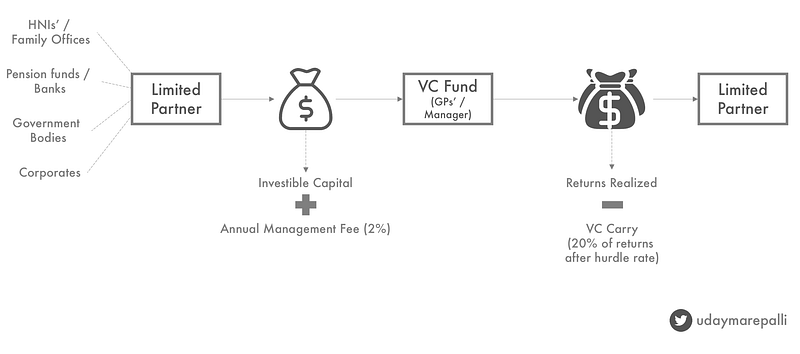
Limited Partner (LP): Invests in venture capital funds. Can be individual / institutional (pension funds/ banks/ HNI family offices).
As a rule of thumb, the following is the priority order in the VCs’ mind-
Foreign institutional > Indian institutional (SIDBI etc.) > Foreign individual > Indian individual
(Your investor list determines your pedigree when you go for the next raise/ institutional investors have appetite to be a part of multiple funds)
The 2% (of fund corpus) annual management fee is to cover the expenses of the VC Fund Manager’s team/ operations.
Hurdle Rate: The minimum assured annual rate of return to the limited partner post which the VC fund manager will look for a share of profits generated. 8% is supposed to be industry standard but first time VCs typically keep it higher to make their fund more attractive.
Carry: The share of future profits the VC manager is entitled to. Usually at 20% of the amount after generating returns exceeding the hurdle rate. First-timers can go upto 15%.
Holding Period: Operating lifetime of the fund over which it generates returns.
IRR: The average annual rate of return the fund plans on making over its life-cycle
The role of a VC Fund Manager comes down to three things:
- Raise money from your limited partners based on your pedigree (investing/ operational) and by promising returns.
- Find, invest and manage startups which can generate enough of returns to satisfy the LPs’.
- Do everything and anything to realise these gains and wire cash back to the LPs’.
(Note that LPs’ come in all the three points!)
What is the cost of failing then?
- A VC- LP relationship is somewhat akin to an entrepreneur- VC relationship (admittedly with more leeway with the 8–10 year time frame). Fail the LP and you can kiss goodbye to him being a part of your next fund.
- Most funds begin preparations to raise their next fund within 3–4 years. The deployment of capital from the first fund should start showing some results to attract the next set of LPs’.
- The VC industry in India is less than 10 years old. But in my opinion, there is no transferrable role for a fund manager. It is a mile wide — inch deep role and requires a lot of focus and generalist skill sets.
A case in point would be Helion Venture Partners which has been unable to raise its 4th fund post differences between the management team and portfolio which doesn’t inspire confidence. I would refrain from making any comments due to lack of first hand information but this article makes a good analysis of what went wrong.
Personally, I think a quantitative approach to looking at things help. This section will also contain a spreadsheet to understand investment and return timelines and the most important component, the IRR.
Before proceeding further, let us take a $50 mn. VC firm ( Imagine Ventures) as an example. It has a 10 year holding period. Let’s assume that the fund operates at the early stage and cuts cheques >750K USD. Here’s how the typical fund disbursal structure will look like:

Now, there is a certain school of thought which says that VC returns follow a power law where the best company has the potential to generate the entire fund.
The next best company will generate returns equivalent to the sum of returns of all the companies after it and so on. This is largely a trend being seen in mature eco-systems (US/ Israel).
In an eco-system like India, we have less number of examples to identify a pattern. At best, around 2–3 funds (SAIF Partners, Saama Capital, Accel India) have successfully managed to deliver on their promised returns.
But what we can look at are the multiples.
Any ambitious fund manager would want to generate at least 4x of the investible capital and through rough estimation, 3x on his fund corpus (after subtracting management fee expenses).
Assuming a 10-year time frame and certain assumptions around capital return timelines, this should translate to a 25% IRR.
(The IRR numbers are always disputed with people saying 18–20% should be acceptable. But some mutual funds give returns > 20% in shorter time frames. Gold and equity markets have been giving around ~15%. If I were a LP, strategic reasons aside, I would look for a premium for the loss in liquidity)
I have added my numbers and assumptions here. You can play around with the figures to understand how the IRR comes about.
Our Imagine Ventures would have to generate around $160 mn.
Assuming the fund has an 7–10% stake during exit , the combined portfolio should be worth anywhere between $1.6- 2.2 Bn. USD.
Statistically speaking, around 50% of the companies fail, the next 30% returns average (~2x) returns, and it is up to the top 20% to deliver the disproportionate ones’.
Let us look at two cases.
The first one is the probability that you have one or two big winners in your portfolio (this theory leads to the power law).
Let’s put this into context. There are 10 companies in India with a valuation>$1 Bn. dollars. I will make an informed guess and put in another 10–15 with valuation >$500 Mn.
At best, around 30 companies among the 4000 odd companies funded from 2007 might have the capacity to give these returns and it is important that our fund (among other 50–80 odd VC funds) holds a stake in 1 or 2 of these if it wants to have a sureshot way of delivering returns.
The other way would be to line up several small success stories. Cobble these together, protect your stake and carefully navigate waters to realize an exit. Have around 20% (~7 companies for Imagine Ventures) of your portfolio hit around $200- $250 mn. in valuation and you reach your $150 mn. figure.
(Hat tip to Blume Ventures here. This is their exit focus and they call such companies as Blue Swans)
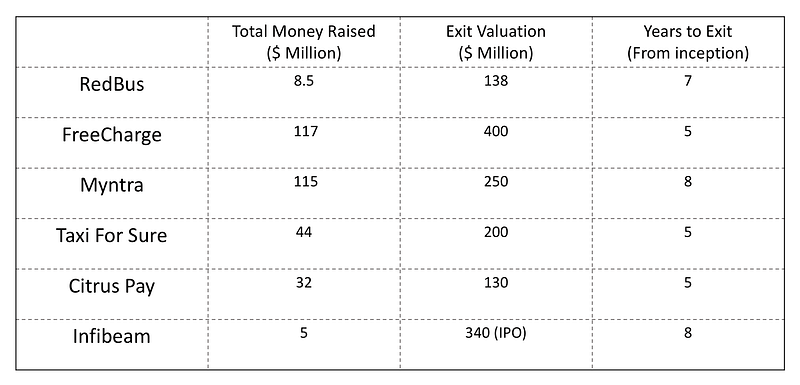
As a reminder, these success stories are spread across several funds. For each and every VC fund to generate similar returns in this range is a tall order in itself (especially when good companies are limited) and this is where the market conditions come into play.
If you are still with me, we are talking about a $50 mn. fund. There are funds with AUM > $100 mn. and the stakes get more higher and tougher to achieve.
With this context, let us talk about a couple of other challenges funds grapple with.
Timing is everything
It was 2006. Two founders just returned from the US and wanted to build a restaurant recommendation platform or the Indian equivalent of Yelp. After a small seed round, it raised a $2 Mn. series A from Network 18.

Competition loomed in the form of Zomato which was more aggressive in its sales. When Zomato raised money, Burrp recognized that it has to do something to maintain its edge. It sold for 4.25 crores to Network 18 in 2009.
Cut to 2017, post multiple rejigs of management, lack of direction and inability to go against its competitors, Burrp sold for a paltry 6.7L, a huge drop by any standards.
Or the news that Snapdeal was being sold at 1/6th of its previous valuation and its previous investors were fighting tooth and nail to protect their interests.
(Your 10% holding in $6.5 Bn. The company is worth $650 mn. It single-handedly gives you 3–4x of your fund corpus if you are a $200 mn. fund. When it erodes to $90 mn., you would put up a fight)
Or that Freecharge was sold for $60 mn. after being bought for $400 mn..
Or that TutorVista was acquired by Byju at less than 5% of the value paid by Pearson to acquire it.
As mentioned, most of these deals would have had a significant stock component involved. But look at how quickly value changes.
The consumer market in India is not a homogenous one. This terrific piece by Haresh Chawla gives you an India about what the internet startups are against. Enterprise startups would be far better selling to the developed markets than to Indian companies. Also, from a talent perspective, our mindset towards jobs and employment makes hiring a bit of a challenge.
Basically, the value can be eroded as quickly as it is created.
And this is where a VC has to rely on his timing.
Your best bets in your portfolio need constant monitoring.
The ones’ in the ICU needs more of it.
You really can’t afford to cash in on your value at a later stage.
And intrinsically, once this mindset sets in, you are playing on backfoot in a game which prides itself on taking risk.
Fun fact: An early stage fund made around 48x on its investment in Snapdeal. Enough to return ~5x of the total fund size.
Ownership % of all
In any race, picking a winner gives any speculator a windfall.
But in the VC race, you need to not only pick a winner but continuously double down/ triple down on your choice.
As an investor, you are open to dilution of your percentage holding of the company’s stock when a follow-on round happens. Typically, over a span of 5 years, expect at least 2–3 rounds of funding to happen.
And you dilute a part of your ownership in every round.
You are in a Catch 22 situation. Your asset is growing in value but your ownership percentage is going down.
Ideally, this wouldn’t have been a problem. But when exits happen, they usually happen at the last valuation of fundraising or at a haircut to it. Once you add in the liquidation preference of a later stage investor, your returns further nosedive.
The rise in valuation is faster in the earlier stages of a company. As and when it goes for higher rounds, later stage investors cease to value growth potential and lean towards traditional multiples.
And holding small stakes in your winners means you are getting the short end of the rope irrespective of your conviction.
You don’t want to own 2% of a business which exits for $200 mn. Not when you backed it first.
And holding stock of the acquiring company is not an ideal option too. You never know how the returns would pan out. Again, the pain of small investors and funds (tucked away in the others section) who have had their portfolio exit to Snapdeal is a testament to this.
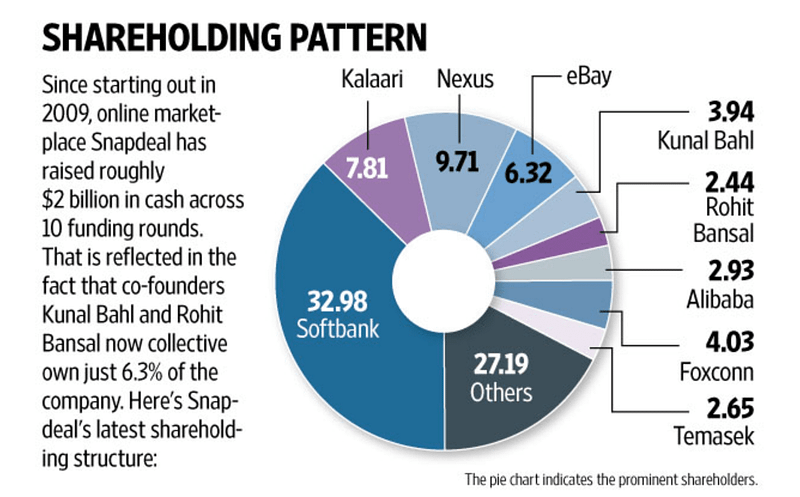
This is compounded by the fact that in a maturing eco-system like India, the exits (proper ones’) are far and few. And even when they happen, the cash payout is minimal (20~30% of the exit value).
For this reason, VCs earmark a piece of their fund (~25%) to participate in the follow-on rounds of their star portfolio companies. And this reduces the dry powder to invest in new ones’ as they finish 2–3 years of their fund cycle.
The mandate is clear. Every firm wants to have a double-digit stake in the winning companies. Anything less is not acceptable.
Participation rights, downside protection, penalty on non-meeting targets and other clauses are majorly aimed to cater to this purpose.
Cross-over structures
The need to maintain ownership structures and associate themselves with a portfolio from an early stage is making VCs’ come in at an earlier stage than they usually invest at.
Funds like Sequoia (corpus > $900 mn.) cut cheques worth $20 mn. and above. They would need returns to be at scale to justify putting not only their money but also their time and effort,
At the same time, you see them cutting cheques in the range of $1 mn. This is largely ‘let us test it out’ capital for them as loss of this will not move their needle.
But this could turn out to give excellent returns too. Sequoia did a $2mn. round in Citrus Pay. It topped it up with a $10 mn. cheque in a Series C round of $25 mn. Looking at the numbers, it is clear that they would have at least owned ~35% of the cap table when the $130 mn. acquisition with PayU happened and made around 4x returns.

But on an upside, this is a loss of a deal for a fund manager who cuts smaller cheques.
Similarly, even funds that can go upto $3–5 mn. on a single deal are launching specialized programs to cater to the seed/ pre-series A level. In some cases, they are earmarking a portion to invest only at the early stage. All in all, most players are racing to be the earliest investor in a company.
When good deals are few, and you have a ton of money chasing those few deals, you need to be super competitive to carve a niche.
Unless you perform or are recognized to be the best player in your space, gathering quality deal flow becomes a pain point. Building this kind of a priority destination status takes its own time.
For a handful of good deals, around 50+ venture funds are having their doors open which makes it incredibly tough to catch hold of good deal flow. When a Matrix expands to Delhi or a Lightspeed opens an office in Bangalore, it is an effort to keep their eyes and ears open and be closer to quality entrepreneurs.
Where are the exits?
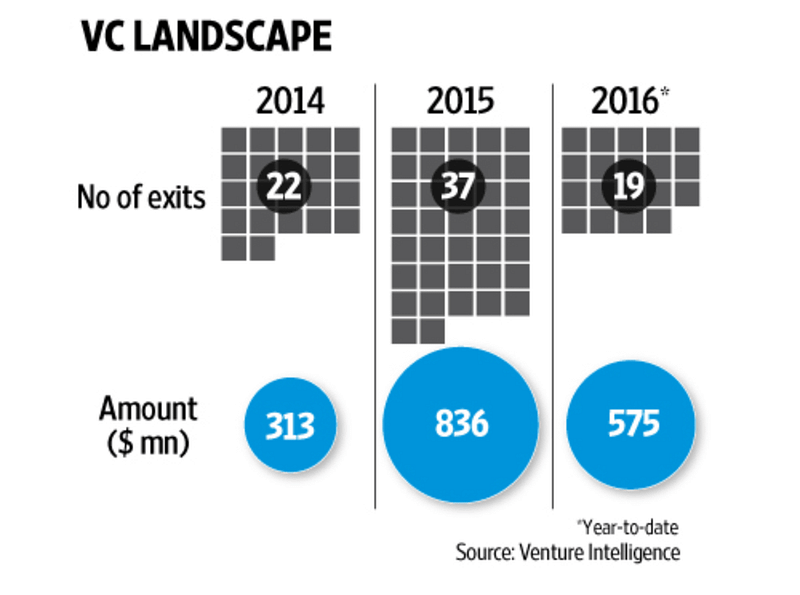
Over the world, exits are seen as signs of a maturing eco-system. A Crunchbase reports mention that India has seen the third highest number of exits for H1 2016.
But why don’t we hear about them in the news or don’t see them among any lists?
Because quite a few of them are not (not even?) venture-backed businesses. And most of the venture-backed ones’ are distressed acquisitions.
The kind where entrepreneurs are realizing that it is difficult to run their business as standalone units.
The kind where VCs’ don’t come forward to fund the business due to a bleak market or not finding it to be a ‘VCeable’ investment.
The kind where the acquirer is doing it by spending their investor cash in order to reach their growth numbers.
Foget generating a 4x multiple on a fund, the return on invested capital for the industry is 0.8x.
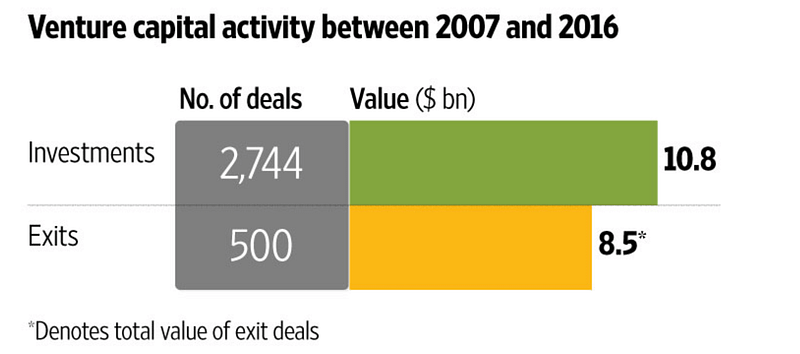
The 10 year time frame might be optimistic too. A majority of investors over estimated India’s potential to transact online. Not just browse but buy. This is one of the reasons why the larger funds like Sequoia and Nexus are trying to deploy capital in US/ Singapore markets. Also, venture funds which were started in 2006–07 are seeking an extension from their LPs’.
Take a look at seedfund’s portfolio. They still have a bunch of companies which they invested in 2006–08 period and are yet to realise returns.
It is a feeding funnel
Ideally, I would want our portfolio companies to raise an institutional round of capital. Say around $500K.
The $500K guy (let’s call him Pre-series A guy) will want a Series A round to happen.
The Series A guy will want the company to raise a Series B/C.
The guys operating at a B/C would want a Venture round/ a PE guy to take up the baton.
The PE guy would ideally want the startup to IPO, but what if his assumptions fail?
He would want Softbank to come into the picture!
The point here is that everybody wants to feed into a higher funnel because you need cash to run the business. (Being profitable across the table is an option but again, there are markets/ business areas where you have to spend to win. More so if you are a B2C player. Again, remember Flipkart’s acquisition of Jabong and Myntra?)
IPOs’ are a long way away if one sees how the current market is shaping up.
So, before every investment, every players in this value chain should figure out how much of capital does a company need from him, for what duration, how would/ how fast the company needs to grow post that and if the company would make an attractive bet for the next guy to come in.
And also that later stage investors are always more selective as shown here:

Funding according to the stage of the company for 2016. Source: Yourstory Research
Sometimes, an entrepreneur might have a great business which is growing month on month but if it doesn’t fit into this framework, it will be passed upon.
Top Heavy structures
Success lies in not investing but taking it to a full cycle and realising exits (and wiring back money to the limited partners).
The firm usually relies on the General/ Venture Partners to devote their time to the growth of the company by leveraging their experience and connections. The imperative to generate returns, across fund sizes, leads to a top-heavy structure.
The managing partners look into deals but also communicate with the Limited Partners and are perpetually on the scout for new ones’ for the next fund.
Funds with AUM < $20 Mn. will just have two-three partners supported by one junior staff, funds between $20–40 mn. will have a couple of analyst/ associates helping them and funds >$50 mn. will keep adding staff to run interference on the portfolio and evaluate deals.
Venture capital is unscalable. Production equals the time each partner has.
– Bill Gurley
Let us take the activity that I do as a part of the investment team.
In any given week, I am talking to startups which have applied to us/ have been referred to us, co-ordinate negotiations with the ones’ in the investment pipeline, monitoring the space where our portfolio companies are operating in and their progress, or doing my own research over prospective trends which are shaping up. Added to this are a few administrative/ operations related tasks that are essential to keep the company moving.
Now translate this to a fund for whom the stakes and need for quality deal flow is higher.
Assuming there are 2 Analysts, and each one can do a thorough review of around 4 deals in a month (trust me, this four is after narrowing down the funnel), they can process around 8–10 such companies.
We receive around 30 decks/ pitches on a monthly basis. A fund receives a higher number in my opinion.
That is when they begin to close doors and general ways of applying such as website links/ linked connect cease to matter. The best deals come via an existing portfolio founder’s referral, a close personal contact and other proprietary access.
And in hindsight, this acts as a great way of cutting through the noise too.
I would like to end this with one final thought.
Investing is as subjective as it gets
Guided by a critical eye, partly because of the market conditions and the odds they are set against, a VC will look at reasons why a company would fail. A euphemism for this would be, ‘I don’t think you can scale’.
There are no hard and fast rules for investing.
From a global perspective, Chris Sacca passed on Dropbox, Pinterest and Snapchat.
Ron Conway, Silicon Valley’s super angel who invested in Google, PayPal and Reddit passed on Salesforce becuase he thought their $30 mn. valuation was too high. Salesforce is worth $70 bn. now.
In fact, Bessemer has taken this a notch up by publishing an entire list of its anti- portfolio (or what could have been a part of its portfolio). In its long history, the company has passed on investing opportunities in technology firms including Apple, Facebook eBay, Google, Intuit and a ton of others.

Closer home, RedBus, the bus ticketing service which was acquired by GoIbibo was passed on by a couple of VCs’. Considering that we are yet to open up regarding our misses, it will take time to know the other ones’ on the list (up for a new VC twitter challenge?)
But what does this tell us about the decision-making of a VC?
Those opportunities are not seen in the same way.
It is a business which makes bets with limited information.
For early stage investors, it gets muddier. Companies try to quickly pivot in search of a product market fit or business model fit based on what they hear from the ground.
One of our portfolio companies was into virtual headsets when we invested. Around 12 months down the lane, they were experimenting with providing intelligent solutions to the BFSI companies. What moved the needle for their series A investor was the intelligent game development program they were working on.
Another company raised a certain amount of money based on a projected business plan and market assumptions. The market quickly moved with the entrance of 3–4 players whose promoters were willing to pour their own cash.
Needless to say, and irrespective of the efforts put in, it had to shut down.
Apart from the usual execution risk, there are regulatory concerns, hiring troubles, founding team splits and bad press which can come to bite you any day. The whole chatter and amplification about whatever happens in the venture world adds to this. The varied combination of these factors ensure that there is no right opinion about where a company is headed.
That’s a wrap on this piece folks. The next time you sit across a VC, do understand that they are entrepreneurs too and have a ton of challenges.
And that this comic might not represent the best approach-
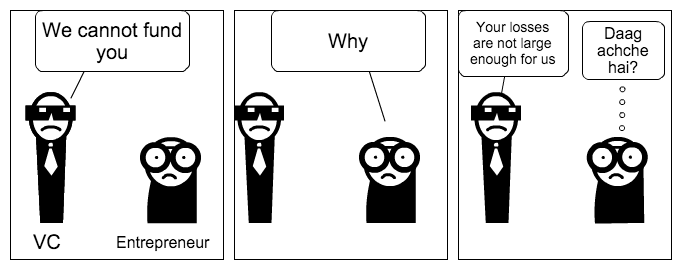
[This post by Uday Marepalli first appeared on Medium and has been reproduced with permission.]


























